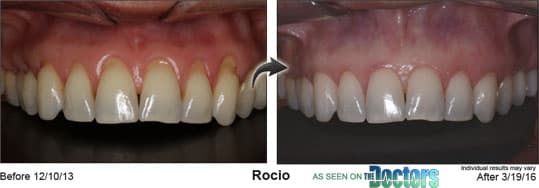Pinhole Gum Rejuvenation by Dr. Michael Pawlus
If Gingival Recession (also known as receding gums) has you smiling with embarrassment, perhaps it’s time to consider Pinhole Gum Rejuvenation. Certified to perform this dramatic surgical breakthrough, Dr. Pawlus is here to help you begin your gum rejuvenation process.

What is Pinhole Gum Rejuvenation?
Pinhole Gum Rejuvenation is a scalpel free, suture free, graft free, minimally invasive procedure that corrects gingival recession (receding gums).
What is the Traditional Treatment for Gingival Recession (Receding Gums)?
Traditionally, gingival recession was treated/corrected with a gingival graft. A dentist would make an incision on the area of the patient’s mouth where the recession existed. A graft from the patient’s palate was then taken and transferred to the recessed site, and the tissue was re-approximated back together with sutures. Because there were two surgical sites and sutures, traditional gingival recession treatment was a painful procedure. While everyone heals differently, in general, traditional gingival recession treatment requires a three to six-month recovery.
What are the Advantages of Pinhole Gum Rejuvenation?
With Pinhole Gum Rejuvenation, a major advantage is the ability to treat as many teeth in one sitting as you desire. Also, Dr. Pawlus can correct your receding gums in as little as one treatment, depending on how badly the gum has receded and how many teeth are being treated. Usually, your treatment session will take one to two hours, and the pinholes in the gum heal in about 24 hours. Another benefit to Pinhole Gum Rejuvenation is that most patients report only minimal discomfort and swelling, and do not require pain medication since there are no incisions or sutures. For those patients who do feel some discomfort, Advil is recommended.
What Causes Gingival Recession (Receding Gums)?
Gingival recession can be caused by a number of things, such as periodontal disease that may stem from a patient’s lack of home care, or overzealous brushing—applying too much pressure in an effort to get cleaner teeth. In women, hormonal shifts can cause gingival recession, but one of the most common causes of gingival recession is grinding and clenching the teeth. During sleep, many people grind their teeth but are unaware they are doing so. The grinding and clenching of the teeth places pressure on the teeth and can cause gingiva to recede. Misaligned teeth can also contribute to gingival recession.
How is Pinhole Gum Rejuvenation Performed?
Using specially designed instruments, the procedure is performed by making small holes with a needle into the gum tissue. After these small holes are made, the gum tissue is loosened and guided over the receded part of the tooth without the need for suturing, dressings or tissue adhesive. The elimination of the need for sutures is a unique aspect of this procedure, and there is also no tissue harvested from elsewhere in the body or from a donor. Since there is no cutting or stitching, patients can expect minimal post-operative symptoms (pain, swelling and bleeding), and most patients also are pleasantly surprised by the instant cosmetic improvement.
What Should I Do After My Pinhole Gum Rejuvenation?
Although the Pinhole Gum Rejuvenation is a minimally invasive process, post-op instructions are very rigorous. The aftercare instructions must be followed carefully, or the patient risks reversing the procedure. Dr. Pawlus will instruct patients to rinse the surgical area with an oral rinse and avoid brushing or flossing the gum area for six to 12 weeks. Even though patients experience very little pain following the procedure, there may be a considerable amount of swelling that subsides after about seven days. Over the next three to four months, the gingiva will settle and re-establish periodontal attachment to the previously exposed root surface.
Can Anyone Have Pinhole Gum Rejuvenation?
As with any surgical technique, there are limits to the success of Pinhole Gum Rejuvenation. The most important factor is the patient must be healthy enough to be a good surgical candidate. Heavy smoking, uncontrolled or poorly controlled diabetes and certain medications are just some of the factors that can compromise the healing process and increase the risk of complications. As with other root-coverage therapies, patients should be free of active periodontal disease or severe gingival inflammation prior to Pinhole Gum Rejuvenation being performed. Finally, patients should demonstrate compliance with periodontal recall appointments and home care instructions.
There are also anatomical factors to account for when considering Pinhole Gum Rejuvenation, including but not limited to location of defect, severity of defect, presence or absence of bone loss.
If you have receding gums and are looking for a less painful, faster and cost-effective alternative to conventional gum grafting, Pinhole Gum Rejuvenation may be for you. If you have questions or wish to schedule a consultation, contact Dr. Michael Pawlus and his highly qualified staff today
Before & After Case Studies
A picture is worth a thousand words. Check out how we restore gum health and get patients on track.
Gum recession and disease can lead to a host of other conditions throughout the body. Get healthy gums and get on with your life.
Dr. Pawlus trained in Chao Pinhole Technique by Dr. Chao - Photos courtesy of Dr. Chao.







